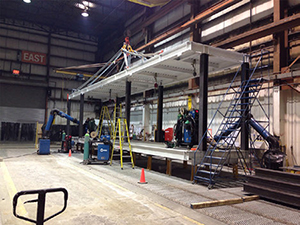
By Rachel Schiebout
As the need for data center construction continues to grow, prefabricated products and modules can offer a viable solution to expedite the building process to meet market demand. Modules are an efficient and flexible approach to meeting an ever-growing market segment, creating high performance customizable structures and systems. These systems provide many advantages needed to meet requirements of this dynamic segment.
If you’ve ever watched Netflix, posted to Facebook or sent an email – you’ve used a data center without knowing. These buildings are where the rows of servers that store digital files such as photos, videos and more are housed. Data centers can be private, provide colocation services where businesses rent space in a third-party facility for servers and computing hardware, or house edge computing that processes data as close to the user as possible to reduce latency through connection to larger central data centers.
Increasingly, modular construction is being leveraged to build data centers of all formats quickly without sacrificing quality. During modular construction, individual sections of a building, or modules, are fabricated off-site with traditional assembly line methods. Predetermined specifications for mechanical, electrical and operational needs create a fixed and controlled cost. The process offers great flexibility in the building design. A modular building can be easily updated by swapping out modules for new pieces with newer equipment, adding modules to increase space, or disassembling and reassembling the modules in a new area.
 Entire buildings are produced with modules that are put together on site without compromising the design or specifications of the project. The modular process adds value to the scalability of each facility with these high volume and repeatable units, as it is easy to create and construct designs for a facility to meet unique requirements. It’s possible to create solutions for addition to an existing project, for future expansion or updates with the newest technologies and components at any time for any capacity. It’s also possible to disassemble the modules completely.
Entire buildings are produced with modules that are put together on site without compromising the design or specifications of the project. The modular process adds value to the scalability of each facility with these high volume and repeatable units, as it is easy to create and construct designs for a facility to meet unique requirements. It’s possible to create solutions for addition to an existing project, for future expansion or updates with the newest technologies and components at any time for any capacity. It’s also possible to disassemble the modules completely.
Modular structures are entirely custom designed to accommodate any computing or technology need, making them suitable for any data center application. Modules offer benefits for meeting the demand for high-quality products with quick build schedules to meet the onslaught of demand for data centers and their requirements. Prefab processes allow all pieces and parts to be built in a controlled environment, shipped, and erected on site, creating a quick and efficient building system. This schedule allows owners and builders the ability to effectively meet schedule demand, while minimizing site and project delays and reducing overall costs. Providing the ability for client customization derives huge value when mixed with the benefits of expedited build schedules, quick delivery and installation at relatively low cost.
Modular construction’s unique building process creates environmental benefits as well, since this type of construction allows for reuse of materials, fewer job-site deliveries, and the option to use recycled elements and materials, green-build elements, and enhanced insulation. Since modules are assembled in an off-site controlled environment, construction and demolition waste is greatly reduced, there are fewer site disturbances, and modular buildings can be disassembled and refurbished, reducing the need for raw materials. The Waste & Resources Action Program (WRAP) specifies a 90% waste reduction through the increased off-site manufacturing and production.
Through the reduction of power required to operate data centers, and through sourcing the power from renewable energy sources, a data center’s carbon footprint can be greatly reduced. The IDC predicts that 1,014 metric tons of CO2 will be prevented from release into our atmosphere through the use of cloud migrations occurring from 2021-2024. The cloud refers to software and servers that run and store data on the Internet rather than a personal computer and are accessed through a Web browser or mobile app. By moving workloads to the cloud, providers will utilize efficient power management, higher server implementation and optimized cooling solutions. Modular building allows for optimized design and features to accommodate power and cooling, simplifying scalability to increase data loads. Another key factor in modular construction is the ability to add and support only what is needed so the facility is operating at maximum capacity. Proper capacity planning equals greater energy efficiency, so the opportunities for optimization and critical energy reductions in efficiency are easy to create.
These prefab projects save an average of 30% of construction time when compared to traditional projects due to the ability to manufacture the modules off-site and avoid construction and weather-related delays. Fewer personnel and resources are required as the work occurs in a controlled environment in a supervised facility, reducing cost and greatly reducing the number of workers, helping with the current construction labor shortage. The process also provides cost savings on installation since pre-assembled solutions are less expensive to operate as all components are optimized to work together.
Another time-saving advantage is the ability for site preparation to occur simultaneously with module production. Once all modules have been through a rigorous testing process, the modules are placed onto truck beds and then individually shipped to the project site. The completed modules are then assembled in the planned order and handed off to the on-site construction team as a finished product.
Efficiency and optimization are key factors when choosing a modular data system to meet the changing market demands. As the need for data centers and their requirements continue to increase, and greater versatility is required for data analytics storage, colocation, and edge facilities, modular components will continue to provide a cost-effective approach with lasting benefits.
For more information, please contact Rachel Schiebout at [email protected].